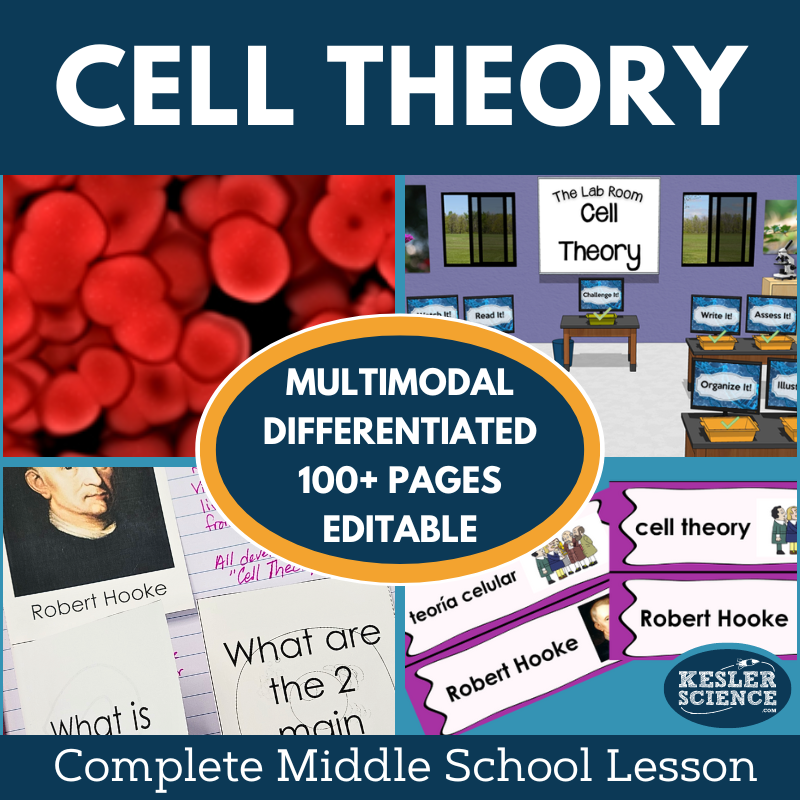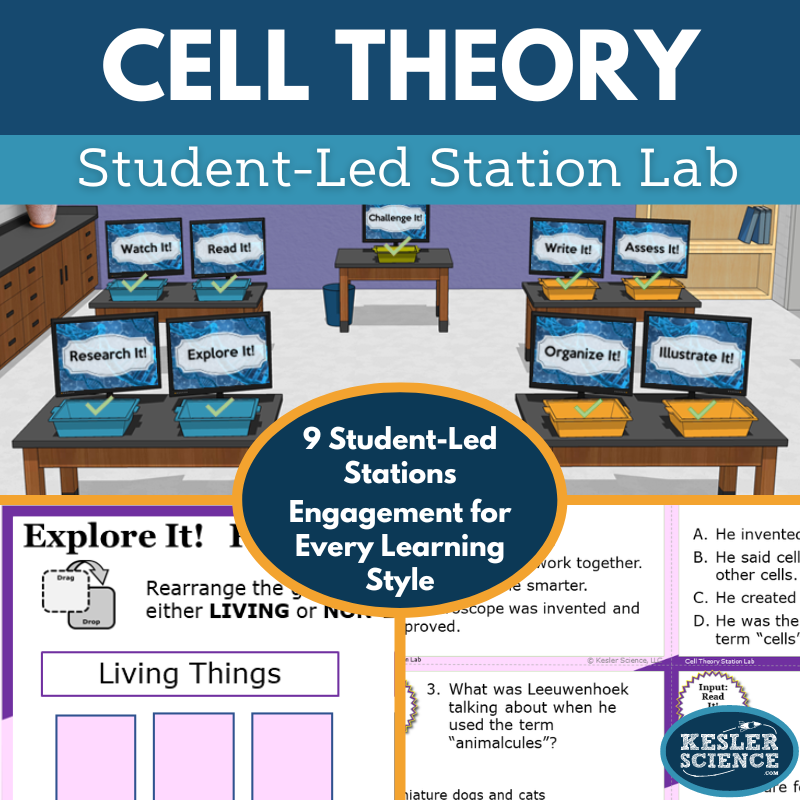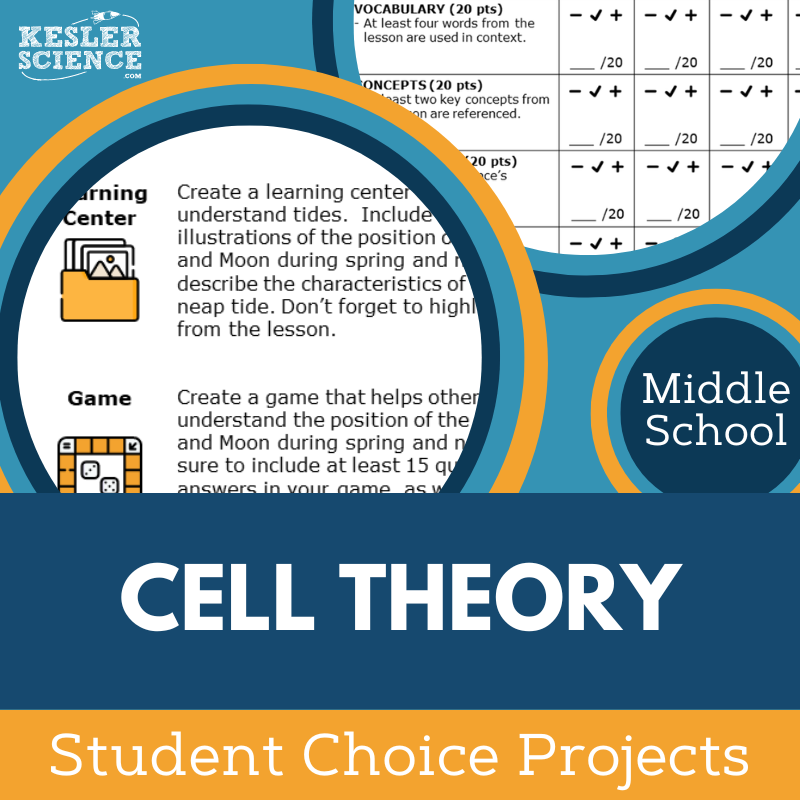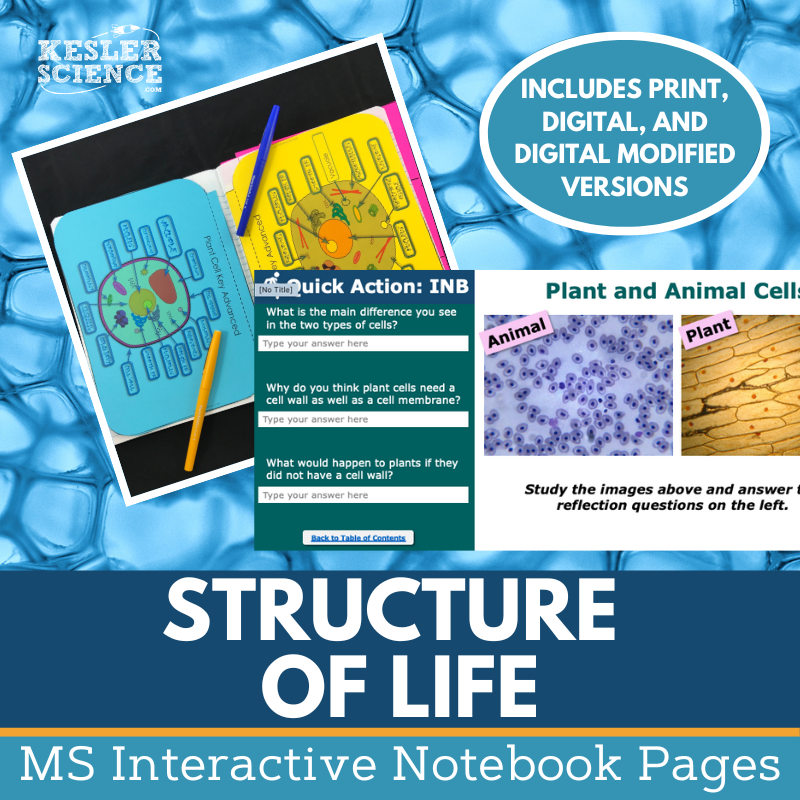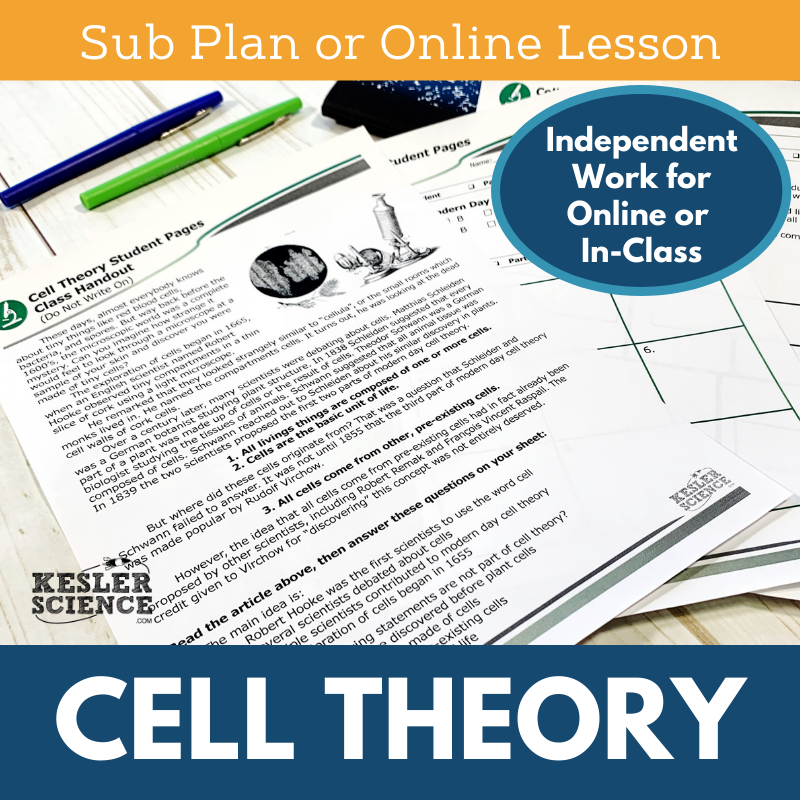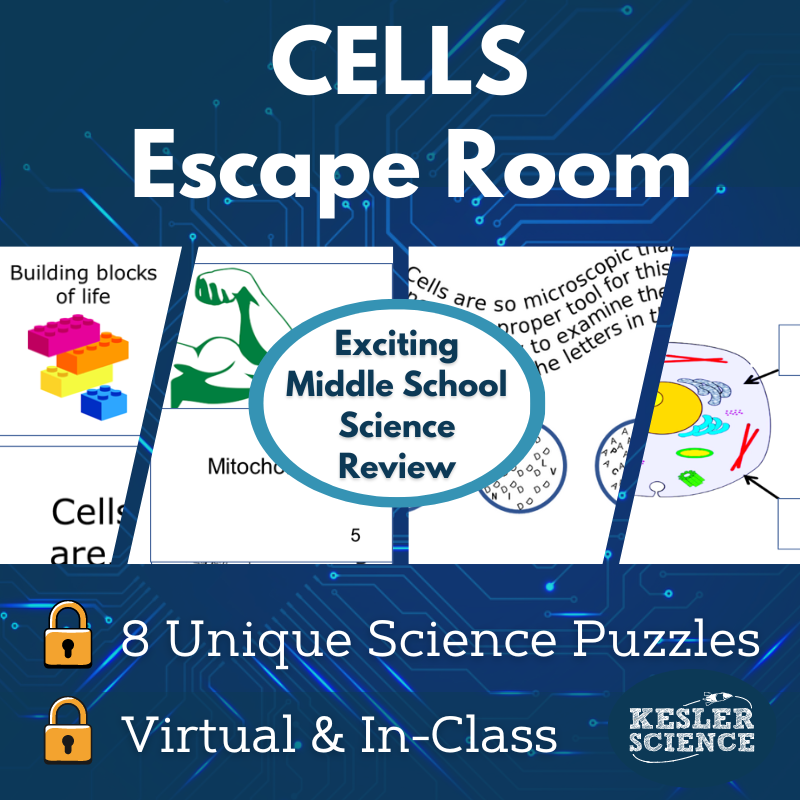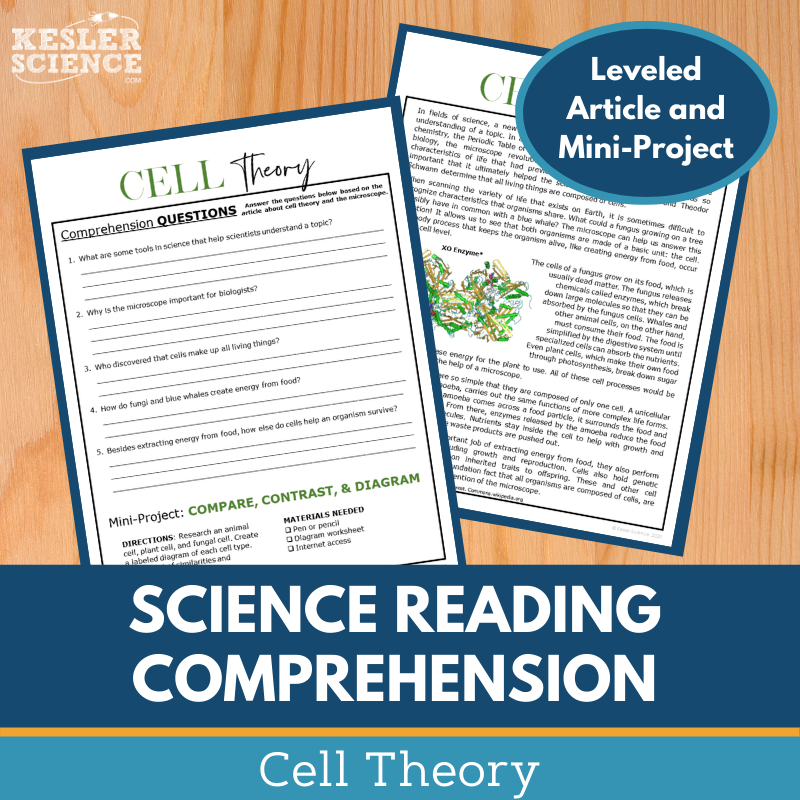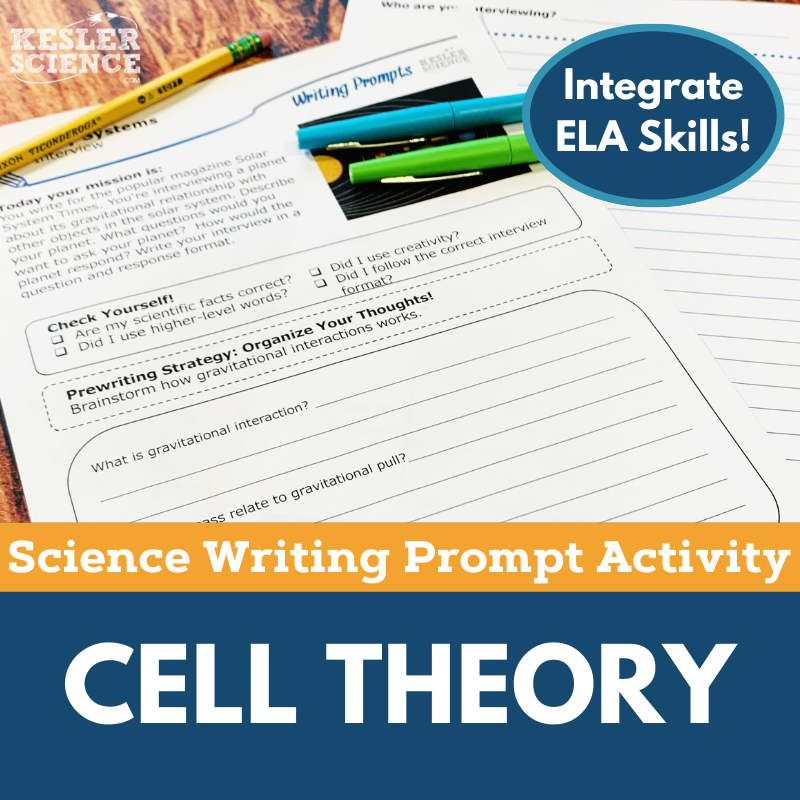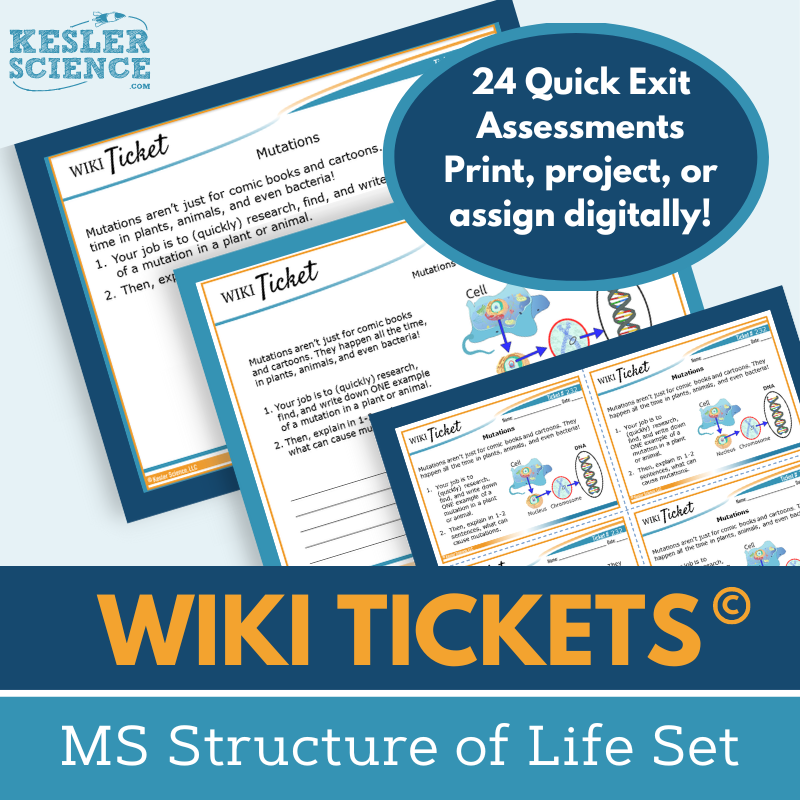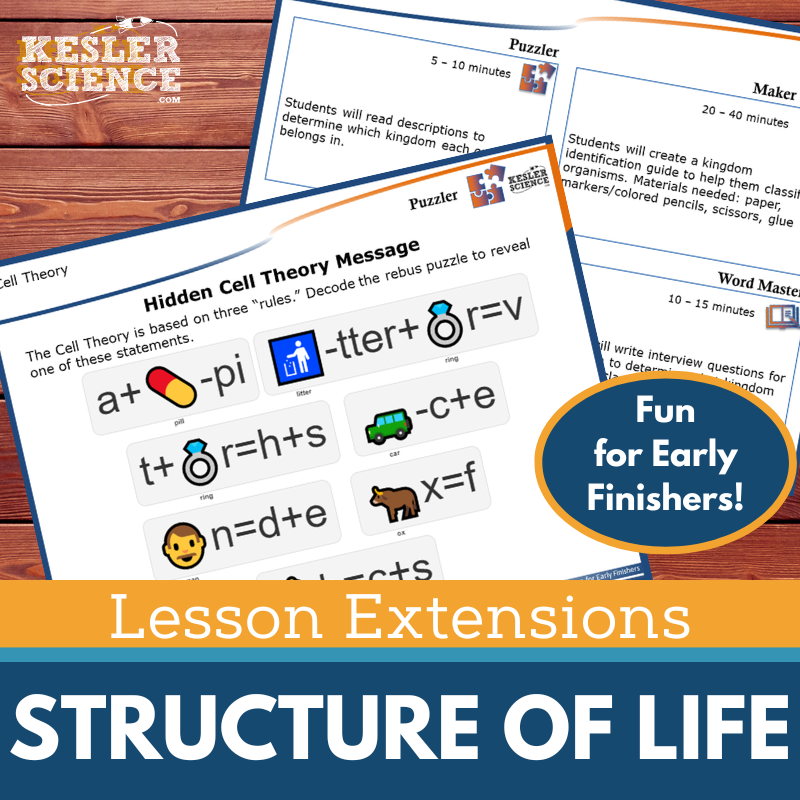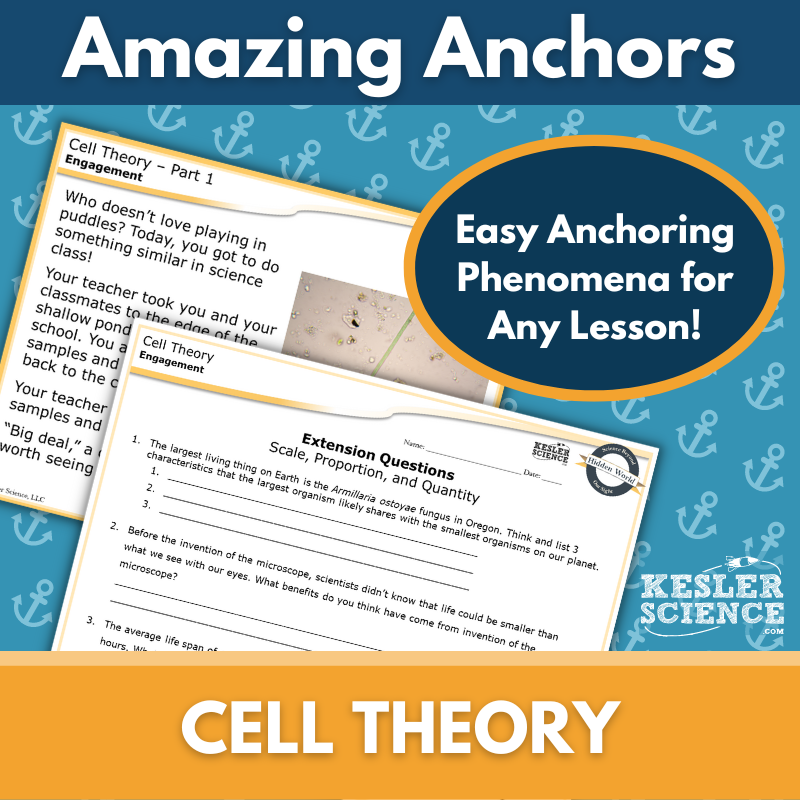Cell Theory Activities for Middle School Science
The Kesler Science Cell Theory resources offer a comprehensive, student-centered approach to understanding the foundational principles of cell theory. The resources below will give students a comprehensive understanding of cell theory. All of the following materials are also included in the Kesler Science Membership.
The Kesler Science Cell Theory 5E Complete Lesson provides a structured, engaging experience for middle school students, focusing on the essential questions: "What is the cell theory?" and "What are the similar functions of all cells?" This lesson follows the 5E Model, ensuring students are actively involved through stages of Engagement, Exploration, Explanation, Elaboration, and Evaluation. The lesson is designed for flexibility, with materials available in both print and digital formats, along with Spanish translations for inclusivity.
During the Exploration phase, students engage with a differentiated station lab with nine stations that cater to various learning styles. Input stations such as "Explore It!" and "Research It!" allow students to interact with the content through hands-on experiments, reading, and online research. Output stations like "Illustrate It!" and "Assess It!" provide students with opportunities to demonstrate their understanding through creative activities and assessments.
For the Explanation and Elaboration stages, editable PowerPoints and interactive notebooks are provided, allowing students to take notes and expand their learning. Extension activities, including student-choice projects, enable further exploration of cell theory concepts. The lesson concludes with evaluation questions and review activities, reinforcing student learning and providing opportunities for self-assessment. Additionally, the lesson is designed for both in-class and virtual learning environments.
The Kesler Science Cell Theory 5E Complete Lesson provides a structured, engaging experience for middle school students, focusing on the essential questions: "What is the cell theory?" and "What are the similar functions of all cells?" This lesson follows the 5E Model, ensuring students are actively involved through stages of Engagement, Exploration, Explanation, Elaboration, and Evaluation. The lesson is designed for flexibility, with materials available in both print and digital formats, along with Spanish translations for inclusivity.
During the Exploration phase, students engage with a differentiated station lab with nine stations that cater to various learning styles. Input stations such as "Explore It!" and "Research It!" allow students to interact with the content through hands-on experiments, reading, and online research. Output stations like "Illustrate It!" and "Assess It!" provide students with opportunities to demonstrate their understanding through creative activities and assessments.
For the Explanation and Elaboration stages, editable PowerPoints and interactive notebooks are provided, allowing students to take notes and expand their learning. Extension activities, including student-choice projects, enable further exploration of cell theory concepts. The lesson concludes with evaluation questions and review activities, reinforcing student learning and providing opportunities for self-assessment. Additionally, the lesson is designed for both in-class and virtual learning environments.
The Kesler Science Cell Theory Station Lab is a modular, student-led activity designed to engage middle school students while exploring cell theory. With eight differentiated activities and a ninth challenge station for early finishers, this student-centered approach allows learners to direct their own learning, making the lesson highly personalized. The teacher facilitates, providing support as needed, while students work independently or in small groups to complete the stations.
The station labs offer both input and output opportunities for students to explore and demonstrate their understanding. Input stations like "Explore It!" and "Research It!" allow students to engage with the content through hands-on activities, reading, and videos. Output stations such as "Illustrate It!" and "Write It!" offer ways for students to organize, visualize, and communicate their knowledge of cell theory.
This resource is fully differentiated, with stations catering to a variety of learning needs and available in both print and digital formats. The digital version allows for remote learning, using platforms like PowerPoint and Google Slides to enable students to manipulate images and complete tasks.
The Kesler Science Cell Theory Station Lab is a modular, student-led activity designed to engage middle school students while exploring cell theory. With eight differentiated activities and a ninth challenge station for early finishers, this student-centered approach allows learners to direct their own learning, making the lesson highly personalized. The teacher facilitates, providing support as needed, while students work independently or in small groups to complete the stations.
The station labs offer both input and output opportunities for students to explore and demonstrate their understanding. Input stations like "Explore It!" and "Research It!" allow students to engage with the content through hands-on activities, reading, and videos. Output stations such as "Illustrate It!" and "Write It!" offer ways for students to organize, visualize, and communicate their knowledge of cell theory.
This resource is fully differentiated, with stations catering to a variety of learning needs and available in both print and digital formats. The digital version allows for remote learning, using platforms like PowerPoint and Google Slides to enable students to manipulate images and complete tasks.
The Kesler Science Cell Theory Student Choice Projects allow middle school students to select a project that suits their learning style and creativity. With six project options plus a "design your own" choice, students have the flexibility to showcase their understanding in a personalized way. Teachers can modify the included rubric to assess vocabulary, concepts, presentation, clarity, and accuracy, and even use peer or self-assessment.
The project options are differentiated to meet the needs of all learners. Three of the options are tailored for students who need additional support, while the remaining choices provide challenge opportunities for advanced students. This ensures that every student can engage meaningfully with the material at their own level.
Teachers can easily implement these projects using standard classroom supplies like paper, markers, and scissors, with some optional crafting materials for model-building. Many of the projects can also be completed digitally, making them adaptable to both in-person and remote learning environments.
The Kesler Science Cell Theory Student Choice Projects allow middle school students to select a project that suits their learning style and creativity. With six project options plus a "design your own" choice, students have the flexibility to showcase their understanding in a personalized way. Teachers can modify the included rubric to assess vocabulary, concepts, presentation, clarity, and accuracy, and even use peer or self-assessment.
The project options are differentiated to meet the needs of all learners. Three of the options are tailored for students who need additional support, while the remaining choices provide challenge opportunities for advanced students. This ensures that every student can engage meaningfully with the material at their own level.
Teachers can easily implement these projects using standard classroom supplies like paper, markers, and scissors, with some optional crafting materials for model-building. Many of the projects can also be completed digitally, making them adaptable to both in-person and remote learning environments.
The Kesler Science Structure of Life Interactive Notebook Bundle provides an engaging way for students to explore life science concepts through interactive activities. Designed for both print and digital use, this resource is perfect for traditional classrooms, 1:1 environments, and distance learning. Topics covered include cell theory, genetics, plant and animal cells, and more, offering a comprehensive tool for teaching the structure of life.
The digital version includes a unique interactive notebook PowerPoint that can be uploaded to platforms like Google Slides or MS Teams, complete with reflection pages, note spaces, and an answer key. A modified digital version is also provided for students needing accommodations. The paper version features blank and pre-filled templates, along with color photos to guide usage, ensuring all students can participate effectively.
With resources tailored for diverse learning needs, the Kesler Science Structure of Life Interactive Notebook Bundle supports differentiated instruction and student-centered learning. Teachers gain a versatile tool for enhancing understanding, while students build lasting connections to key life science concepts.
The Kesler Science Structure of Life Interactive Notebook Bundle provides an engaging way for students to explore life science concepts through interactive activities. Designed for both print and digital use, this resource is perfect for traditional classrooms, 1:1 environments, and distance learning. Topics covered include cell theory, genetics, plant and animal cells, and more, offering a comprehensive tool for teaching the structure of life.
The digital version includes a unique interactive notebook PowerPoint that can be uploaded to platforms like Google Slides or MS Teams, complete with reflection pages, note spaces, and an answer key. A modified digital version is also provided for students needing accommodations. The paper version features blank and pre-filled templates, along with color photos to guide usage, ensuring all students can participate effectively.
With resources tailored for diverse learning needs, the Kesler Science Structure of Life Interactive Notebook Bundle supports differentiated instruction and student-centered learning. Teachers gain a versatile tool for enhancing understanding, while students build lasting connections to key life science concepts.
The Kesler Science Cell Theory Sub Plans provide a complete, engaging lesson to ensure smooth classroom management in your absence. The lesson includes a warm-up puzzle, a reading passage with a timeline activity, and a cell theory memory game. Early finishers can extend their learning by writing a creative letter as Robert Hooke or illustrating his 1665 microscope observations. Students complete the lesson with an assessment or exit ticket.
These sub plans are thoughtfully designed with detailed instructions, behavior checkpoints, and answer keys, making them easy for substitutes to follow. The materials are also perfect for distance learning, with a Google Form answer sheet, a student-only PDF for annotations, and compatibility with LMS platforms like Google Classroom.
With editable documents, clear student expectations, and engaging activities, these sub plans are versatile for use as homework, extra credit, or small group lessons. Whether in class or online, Kesler Science Sub Plans provide a seamless, student-centered solution for any teaching situation.
The Kesler Science Cell Theory Sub Plans provide a complete, engaging lesson to ensure smooth classroom management in your absence. The lesson includes a warm-up puzzle, a reading passage with a timeline activity, and a cell theory memory game. Early finishers can extend their learning by writing a creative letter as Robert Hooke or illustrating his 1665 microscope observations. Students complete the lesson with an assessment or exit ticket.
These sub plans are thoughtfully designed with detailed instructions, behavior checkpoints, and answer keys, making them easy for substitutes to follow. The materials are also perfect for distance learning, with a Google Form answer sheet, a student-only PDF for annotations, and compatibility with LMS platforms like Google Classroom.
With editable documents, clear student expectations, and engaging activities, these sub plans are versatile for use as homework, extra credit, or small group lessons. Whether in class or online, Kesler Science Sub Plans provide a seamless, student-centered solution for any teaching situation.
The Kesler Science Cells Escape Room transforms learning into an interactive adventure where students demonstrate their knowledge of cells and organelles through engaging puzzles. With eight independent puzzles, teachers have full control over which to use and the order of play, making the activity adaptable for any class period. Whether using printed materials in manila envelopes or incorporating locks and props for a more authentic escape room feel, this resource offers a dynamic way to reinforce life science concepts.
The escape room includes all necessary materials, from teacher directions and detailed answer keys to a digital answer sheet perfect for Google Classrooms. Students can participate in a digital version using Google Slides or complete a print version at home, ensuring flexibility for virtual or in-person learning. Optional enhancements like UV pens, magnifying glasses, or microscopes add excitement to the experience.
With a video challenge to set the mood, printable reward templates, and editable props, this escape room encourages teamwork and problem-solving. It’s a perfect way to captivate students, foster collaboration, and deepen their understanding of cells in a fun, immersive setting.
The Kesler Science Cells Escape Room transforms learning into an interactive adventure where students demonstrate their knowledge of cells and organelles through engaging puzzles. With eight independent puzzles, teachers have full control over which to use and the order of play, making the activity adaptable for any class period. Whether using printed materials in manila envelopes or incorporating locks and props for a more authentic escape room feel, this resource offers a dynamic way to reinforce life science concepts.
The escape room includes all necessary materials, from teacher directions and detailed answer keys to a digital answer sheet perfect for Google Classrooms. Students can participate in a digital version using Google Slides or complete a print version at home, ensuring flexibility for virtual or in-person learning. Optional enhancements like UV pens, magnifying glasses, or microscopes add excitement to the experience.
With a video challenge to set the mood, printable reward templates, and editable props, this escape room encourages teamwork and problem-solving. It’s a perfect way to captivate students, foster collaboration, and deepen their understanding of cells in a fun, immersive setting.
The Kesler Science Cell Theory Reading Comprehension Activity engages middle school students with a nonfiction article exploring the components of cell theory. Students enhance their understanding by answering comprehension questions and creating diagrams to compare three types of cells. The leveled passages, appropriate for grades 6-8 (or advanced 5th graders), provide differentiated options to support all learners.
This resource includes two Lexile-leveled articles (1100-1300), comprehension questions, a hands-on mini-project, and a Cornell notes template for organized learning. Teachers can easily integrate the colorful, print-friendly materials into classroom instruction or assign them digitally via Google Classroom, Schoology, and other LMS platforms, ensuring accessibility for in-person and virtual learners alike.
Perfect for sub plans, extra credit, or routine literacy practice, this resource fosters textual analysis, classroom discussions, and science literacy. Its versatile format allows teachers to build reading comprehension skills while connecting students to key life science concepts.
The Kesler Science Cell Theory Reading Comprehension Activity engages middle school students with a nonfiction article exploring the components of cell theory. Students enhance their understanding by answering comprehension questions and creating diagrams to compare three types of cells. The leveled passages, appropriate for grades 6-8 (or advanced 5th graders), provide differentiated options to support all learners.
This resource includes two Lexile-leveled articles (1100-1300), comprehension questions, a hands-on mini-project, and a Cornell notes template for organized learning. Teachers can easily integrate the colorful, print-friendly materials into classroom instruction or assign them digitally via Google Classroom, Schoology, and other LMS platforms, ensuring accessibility for in-person and virtual learners alike.
Perfect for sub plans, extra credit, or routine literacy practice, this resource fosters textual analysis, classroom discussions, and science literacy. Its versatile format allows teachers to build reading comprehension skills while connecting students to key life science concepts.
The Kesler Science Cell Theory Writing Prompt Activity combines creativity and science to help middle school students deepen their understanding of life science. Using a poetry-based prompt, this engaging activity strengthens science reasoning while enriching students’ writing skills. Designed for both in-class and virtual learning, the activity ensures students stay connected and inspired no matter where they are.
This low-prep, high-quality resource includes teacher directions, answer guides, and rubrics to simplify implementation. Students can use full or half-sheet handouts for easy integration into notebooks or journals. The digital version, compatible with PowerPoint and Google Slides, offers a seamless option for remote or blended classrooms.
Whether used for review, elaboration, or cross-curricular integration, this writing prompt fosters creativity and scientific literacy. Its flexible format and innovative approach make it an excellent addition to any Kesler Science lesson or as a stand-alone activity.
The Kesler Science Cell Theory Writing Prompt Activity combines creativity and science to help middle school students deepen their understanding of life science. Using a poetry-based prompt, this engaging activity strengthens science reasoning while enriching students’ writing skills. Designed for both in-class and virtual learning, the activity ensures students stay connected and inspired no matter where they are.
This low-prep, high-quality resource includes teacher directions, answer guides, and rubrics to simplify implementation. Students can use full or half-sheet handouts for easy integration into notebooks or journals. The digital version, compatible with PowerPoint and Google Slides, offers a seamless option for remote or blended classrooms.
Whether used for review, elaboration, or cross-curricular integration, this writing prompt fosters creativity and scientific literacy. Its flexible format and innovative approach make it an excellent addition to any Kesler Science lesson or as a stand-alone activity.
The Kesler Science WIKI Tickets are flexible, engaging formative assessments designed for middle school science topics. The Structure of Life Set includes 24 colorful assessments that can be used as exit tickets, bellringers, or quick checks for understanding. Each topic features five formats: a projection version, three print sizes, and an interactive digital version compatible with PowerPoint or Google Slides.
Aligned with NGSS and TEKS standards, these assessments cover key topics like asexual vs. sexual reproduction, cell functions, heredity, homeostasis, and turgor pressure. The included table of contents helps teachers easily identify alignment with specific standards, ensuring comprehensive coverage. With options for both in-class and virtual learning, these assessments offer maximum flexibility.
These "What I Know Is" assessments provide teachers with a clear picture of student understanding. Whether used in a traditional classroom or a remote setting, they are an easy, engaging way to track progress and identify learning gaps.
The Kesler Science WIKI Tickets are flexible, engaging formative assessments designed for middle school science topics. The Structure of Life Set includes 24 colorful assessments that can be used as exit tickets, bellringers, or quick checks for understanding. Each topic features five formats: a projection version, three print sizes, and an interactive digital version compatible with PowerPoint or Google Slides.
Aligned with NGSS and TEKS standards, these assessments cover key topics like asexual vs. sexual reproduction, cell functions, heredity, homeostasis, and turgor pressure. The included table of contents helps teachers easily identify alignment with specific standards, ensuring comprehensive coverage. With options for both in-class and virtual learning, these assessments offer maximum flexibility.
These "What I Know Is" assessments provide teachers with a clear picture of student understanding. Whether used in a traditional classroom or a remote setting, they are an easy, engaging way to track progress and identify learning gaps.
The Kesler Science Structure of Life Lesson Extensions provide student-choice activities designed to keep fast finishers engaged with critical thinking and creative tasks. These extensions are perfect for wrapping up lessons, filling time during testing, or offering advanced learners opportunities to deepen their understanding of life science concepts. Aligned with NGSS and TEKS standards, the extensions include activities such as puzzles, hands-on Maker Space projects, digital media tasks, and creative writing challenges.
Each Lesson Extension includes teacher directions, answer keys, and both projection and printable versions for maximum flexibility. With topics ranging from cell structure to heredity and natural selection, students can explore concepts through problem-solving, STEAM connections, and creative expression. These activities encourage deeper exploration of topics like artificial selection, genetic mutations, and environmental factors.
Kesler Science Lesson Extensions are ideal for scaffolding learning or challenging independent learners. By incorporating engaging activities like Puzzler, Maker Space, Tech Connection, and Word Master, these resources provide rigorous yet enjoyable options to enrich life science lessons.
The Kesler Science Structure of Life Lesson Extensions provide student-choice activities designed to keep fast finishers engaged with critical thinking and creative tasks. These extensions are perfect for wrapping up lessons, filling time during testing, or offering advanced learners opportunities to deepen their understanding of life science concepts. Aligned with NGSS and TEKS standards, the extensions include activities such as puzzles, hands-on Maker Space projects, digital media tasks, and creative writing challenges.
Each Lesson Extension includes teacher directions, answer keys, and both projection and printable versions for maximum flexibility. With topics ranging from cell structure to heredity and natural selection, students can explore concepts through problem-solving, STEAM connections, and creative expression. These activities encourage deeper exploration of topics like artificial selection, genetic mutations, and environmental factors.
Kesler Science Lesson Extensions are ideal for scaffolding learning or challenging independent learners. By incorporating engaging activities like Puzzler, Maker Space, Tech Connection, and Word Master, these resources provide rigorous yet enjoyable options to enrich life science lessons.
This Amazing Anchors Phenomenon Lesson introduces and reinforces cell theory through real-world connections. Students begin with an introductory reading about microscopic pond organisms, using comprehension and extension questions to spark curiosity. An explanatory reading follows, clearly breaking down the science behind cell theory and reinforcing learning with additional questions.
The resource includes teacher directions, answer keys, and editable materials that are TEKS-aligned. It features projection slides, full- and half-sheet handouts for interactive notebooks, and digital versions compatible with Google Classroom or other learning management systems. A modified version supports differentiated instruction with sentence starters and simplified language.
Designed to complement any middle school lesson, these readings serve as engaging supplements that work well in the Engagement and Elaborate phases of the 5E model. Whether used in person or virtually, this no-prep activity encourages students to explore cell theory through an accessible, real-world lens.
This Amazing Anchors Phenomenon Lesson introduces and reinforces cell theory through real-world connections. Students begin with an introductory reading about microscopic pond organisms, using comprehension and extension questions to spark curiosity. An explanatory reading follows, clearly breaking down the science behind cell theory and reinforcing learning with additional questions.
The resource includes teacher directions, answer keys, and editable materials that are TEKS-aligned. It features projection slides, full- and half-sheet handouts for interactive notebooks, and digital versions compatible with Google Classroom or other learning management systems. A modified version supports differentiated instruction with sentence starters and simplified language.
Designed to complement any middle school lesson, these readings serve as engaging supplements that work well in the Engagement and Elaborate phases of the 5E model. Whether used in person or virtually, this no-prep activity encourages students to explore cell theory through an accessible, real-world lens.
Year-Round Resources
These year-round activities will increase your students' understanding of many middle school science topics. All of these activities are also included in the Kesler Science Membership.
Visual Data & Graphing
You're not alone if your students struggle with understanding graphs, charts, and tables. It's a skill that takes an enormous amount of practice. This resource will help students build a strong foundation in analyzing data and creating their own data visualizations.
Bell Ringers and Warm-Ups
These middle school science bell ringers are an excellent way to engage your students as soon as they walk into your classroom. This comprehensive FULL YEAR resource includes everything you need to start off each science class with an interesting warm-up activity.
Review Board Games
Each game board has been carefully designed to keep students engaged. There are 10 different action spaces on each board and dozens of question cards. All of the actions are related to science concepts and keep the students motivated throughout the game.
Each game is ready to play. Simply print out the board and the cards and let the students enjoy reviewing nine different units.
Essential Questions
Below are the essential questions associated with the lessons and activities included in this unit. This topic is only one of more than 100 middle school science topics included in the Kesler Science Membership.
-
What is the cell theory?
-
What are similar functions of all cells?
Kesler Science Membership
Imagine never having to search for another middle school science lesson again. The membership gives you access to ALL of the Kesler Science products in one place (Yes, including everything above).
Say goodbye to long hours of lesson prep.

